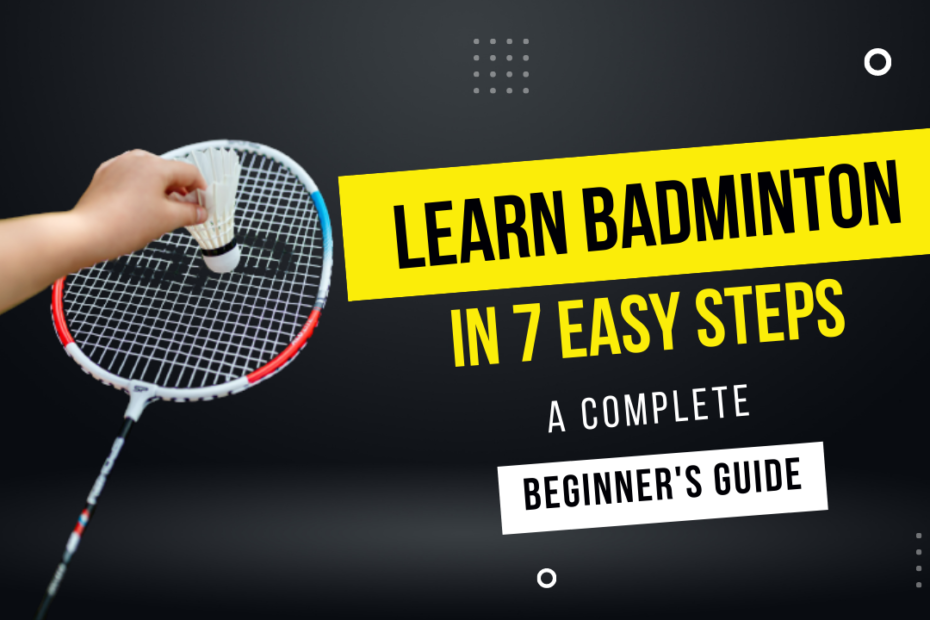Badminton is an indoor game played in a hall with a height of 34 ft; because the shuttlecock is very light and weighs approximately 5 grams (0.17 ounces), its flight can be disturbed due to wind and moisture.
It is usually played on synthetic and wooden courts because they help exert pressure on your knees and provide better cushioning to your feet while performing lunges.
Rather than a shuttlecock, there are other gears, which include a net, racket, shoes, attire, and court.
It is played in two different categories with different rules and regulations.
One game holds three sets of 21 points and to win a match, a player has to win two sets out of these three.
And today, here in this article, we will discuss some basics of this sport.
So if you are a beginner, then these steps will help you to learn this sport effectively:
Learn to Play Badminton in These 7 Easy Steps
Most people play this sport just for fun.
But if you choose it as your career and if you want to go ahead and become a professional player, then you need to take these steps seriously and start working on them:
Step 1- Learn some effective ways to warm up your body
The very first thing you need to do after entering the court is to perform a proper warm-up so that your body and muscles allow you to perform some effective moves.
Performing an effective warm-up also helps you to prevent injuries.
Also, it stretches your muscles, increases your heart rate, and improves your performance and fitness.
Here below, I have mentioned some exercises which can help you in warming up your body:
Jogging and Running

After putting on your full badminton attire, you must go jogging or running.
If you are a beginner, then I’ll recommend you to go for brisk walking, progress to jogging, and then to running.
You must do jogging or running for approximately 20 minutes in winter and approximately 10 minutes in summer.
It is because it takes more time to heat your body than summer.
Also, remember: You must do jogging or running to warm up your muscles, not to tire them, and for this, you need to maintain a consistent speed.
Benefits of jogging and running
- Reduces fat.
- Burn extra calories.
- Maintain your body weight.
- Strengthen your bones and muscles.
- Helps in improving your cardiovascular fitness.
Skipping

Most of the moves here are performed on toes.
So to warm up your foot muscles, I suggest you perform skipping after running for approx 5-10 minutes.
Benefits of skipping
- Improves coordination.
- Boost your stamina.
- Increases your body’s flexibility.
- Helps in improving your heart health.
- Strengthen your bones and muscles.
Neck and Shoulder Rotation

While performing from the backcourt, you might have noticed that many necks and shoulder movements are made while hitting the shuttle.
So to perform those moves effectively, you must perform neck and shoulder exercises adequately.
Warning: If you do not perform this exercise correctly, you can face many problems like strains, shoulder joint instability, and dislocation.
Benefits of shoulder and neck rotation
- Boost your blood circulation.
- Helps to improve workout performance.
- Provides relief from neck and shoulder pain.
- Reduces the risk of shoulder and neck injury.
- Helps to keep your neck and shoulder muscles conditioned.
Wrist Rotation
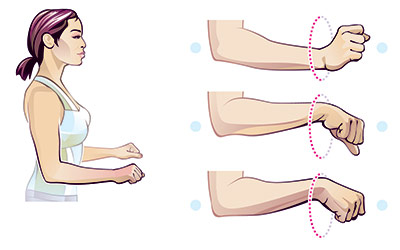
You need to perform a wrist rotation exercise to indulge more power in your shots.
Here you only need to rotate your wrist anticlockwise and clockwise 10-15 times.
Benefits of wrist rotation
- Ease the Stiffness.
- Increases your wrist flexibility.
- Improves blood circulation.
- Helps in changing grips easily.
- Helps in generating more power for your shots.
Knees Exercises

There are more chances of facing knee injuries like tearing muscles and fractures on the court while performing a shot while jumping or suddenly stopping.
So to prevent such knee injuries, you should perform exercises like squats, lunges, and straight & side leg raise to warm up your muscles.
Benefits of knee exercises
- Burns calories.
- Improves flexibility.
- Boost lower-body endurance.
- Improves cardiovascular endurance.
- Strengthen your lower and abdominal muscles.
Ankle Rotation

Ankle rotation is also one of the basic badminton exercises.
You can firmly perform this exercise by touching the ground or a court with your toe tip and rotating it clockwise and anti-clockwise for approximately 2-3 minutes.
Benefits of ankle rotation
- Prevents ankle twisting.
- Improves your flexibility.
- Prevents cramps and sprains.
- Reduces pressure on your feet.
- Helps in releasing stress and tension.
Warning: In case you are facing any such injury and not recovering from it, then I will suggest you consult with Polaris Spine & Neurosurgery Center.
Step 2- Learn how to hold a racket
If you think you can play badminton without learning to hold a racket adequately, then you are wrong because it is one of the foremost things you need to learn before going further in this sport.
If you start playing this sport without learning this skill, then let me inform you that you can face many difficulties.
And I suggest you learn how to hold a racket adequately.
Forehand Grip
The forehand grip is used to perform forehand overhand shots, and it is one of the easiest grips to learn and helps to learn the other grips.
This grip is like shaking hands with your friend, making a V-shaped space between your thumb and index finger.
But remember that your thumb should always remain below your index finger.
Also, try not to tighten the grip, as it will create problems while changing the grip.
The forehand grip is mostly used while performing a forehand clear, smash, slice, forehand lift, forehand drive, forehand serve, and forehand net shot.
To know more, check out the video below:
Backhand Grip
A backhand grip is the second most used grip.
It is also known as a thumb grip and is slightly similar to a forehand grip.
While performing this grip, your thumb should be placed on the wider section of the racket, while the racket strings should be facing upwards.
The backhand grip performs a backhand serve, backhand drive, and doubles defence.
And if you want to learn to hold a backhand grip effectively, then check out the video below:
Bevel Grip
A bevel grip is used for performing backhand, drop, and clear shots from the rare court.
It allows you to rotate your backhand fully, which helps in generating amazing power while hitting the shuttle or performing a backhand clearance.
If you want to know how to hold a beveled grip, then click on the video below:
Hammer and Pan Handle Grip
Hammer and panhandle grips are the most common grips used by kids and beginners while playing this sport.
These grips are mostly used in the court but remember, excessive use of these grips can also get you locked because kids and beginners often think that the racket strings need to be parallel towards the shuttle, but that’s not correct.
Because if you hold your racket with 100%panhandle and hammer grip, then it won’t allow you to move or rotate your forearm, and you can not indulge power to your shots.
Pan-handle and hammer grips are used to perform some powerful smashes and shots.
To know more, click on the video given below:
Step 3- Know the rules and regulations of badminton
Like every other sport, this sport also has different rules and regulations, which I have mentioned below.
Now all you need to do is go through these rules and apply them in your game so that you won’t face any problems while playing any competitive match:
Basic Rules

Here are some basic rules that are applied in both singles and doubles:
- A match always begins with a toss.
- The toss-winning team can decide whether they would like to serve or receive first.
- And the toss-losing team can choose the side of the court.
- A player cannot start the match unless his opponent is ready.
- Remember that your feet must be inside the boundary line of the court while performing a serve.
- If a server misses the shuttlecock while performing a service, he cannot double-hit the shuttle; if he does so, it will be counted as a service fault.
- A player is not supposed to fling and hold the shuttle for a long time.
- A player must not hit the shuttle over the net before entering his court.
- Rather than this, you are also not allowed to disturb your opponent or hold your racket near the net.
Rules for Singles

- A match generally begins with (0-0) scores, but when the score of a server turns even like 2, 4, 6, 8, 10, 12, 14, 16, 18, or 20, then in such case, he needs to serve from the right side of the court, whereas if his score turns odd like 1, 3, 5, 7, 9, 11, 13, 15, 17, 19, or 21 then there he needs to serve from the left side of the court.
- When a server wins a rally or scores a point, he gets a chance to serve again.
- And in case the receiver wins a rally or scores a point, he becomes a new server.
Rules for Doubles

- Likewise, in singles, the same rule applies in doubles, too, where a badminton match starts with (0-0) scores, but when the score of a server turns even like 2, 4, 6, 8, 10, 12, 14, 16, 18, or 20 then in such case he needs to serve from the right side of the court, whereas if his score turns odd like 1, 3, 5, 7, 9, 11, 13, 15, 17, 19, or 21 then there he needs to serve from the left side of the court.
- If the receiving side wins a rally, they become a new server.
- If the serving side wins a rally or a point, they get the chance to serve again.
- Players cannot change their side unless they win a rally or point when their side gets a chance to serve.
Faults

- If the player’s body touches the net while performing a service, then it’s counted as a fault.
- A player is not allowed to hit the shuttle twice.
- One cannot disturb or obstruct his opponent while serving or playing.
- A player should not move or run while performing a serve.
- The feet of the player must be within the boundary lines while performing a serve.
- After performing a service, if the shuttlecock does not land on the right side of the court is also counted as a fault.
- A player performing a service above his waistline is also considered a fault.
Lets

I know some of you might be reading this topic for the first time; if so, don’t worry, and let me explain.
Lets are those calls made by the umpires and players to pause the game temporarily.
And these pauses can be made for various reasons like:
- When the shuttlecock is stuck in the net.
- In case if shuttlecock breaks down.
- If any player faces injuries or gets hurt due to some cause.
- When the umpire is confused and cannot make his decisions.
- When the server performs a serve before his opponent gets ready.
Step 4- Learn to perform basic badminton stance
It is difficult for beginners to learn to stand while playing a shot.
But don’t worry about it because I will explain every stance to you in detail.
And once you master these stances, it will help you perform smooth and quicker movements.
As there are three major types of stance, which I have mentioned and explained below:
Attacking Stance
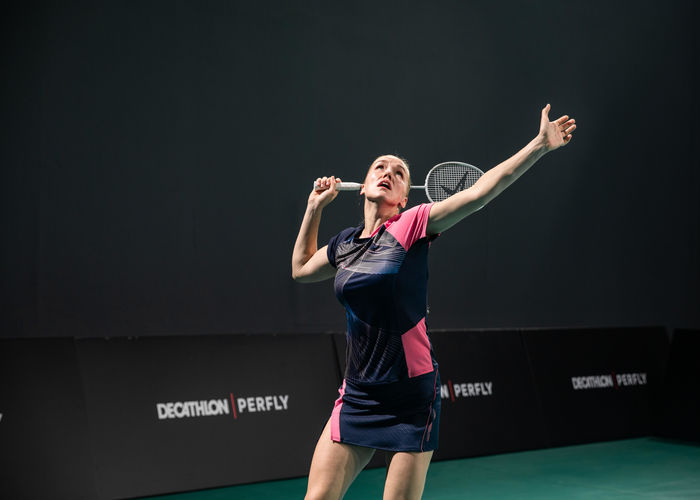
The attacking stance is used while performing a smash, overhead forehand stroke, or hitting any powerful shot against your opponent.
Step-by-step guide
- Move or turn your body to the side court and about 90 degrees to the net.
- Open your legs.
- Now raise your racket and non-racket arm.
- Transfer your body weight to your racket leg.
- Now hit the shuttle.
Where to use
- While performing half or full smashes.
- When you are behind the shuttle.
- When you get a short or high lift in return from your opponent.
Defensive Stance
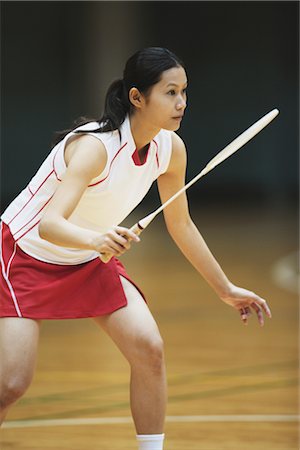
This stance is used while performing some defensive shots.
As in singles, if you use this specific stance, you need to hold your racket a little outwards to help you reach the faraway shot in time.
While in doubles, you must keep the racket flat in front of you to prepare for the next shot.
Step-by-step guide
- Open your feet as wide as your shoulders.
- Bend your knees a bit.
- Lift your body a bit forward.
- Raise both your arms above your waist level.
- Now hit the shuttle.
Where to use
- This stance is used when you are about to hit a high clear or high serve.
- And this stance is commonly performed by doubles in comparison to singles.
Net Stance

Net stance allows you to hit the shuttle as high as possible when you are at the net.
As the net area is very important for every player, you should learn and master this stance.
Step-by-step guide
- First of all, keep your racket foot ahead and non-racket foot backward.
- Place your racket in front of your body, above the waistline.
- Raise your non-racket arm to maintain your body balance.
- Now place your body weight slightly forward and get ready to hit the shuttle.
Where to use
- Net stance is used when you know your opponent will play a net shot.
- To play a perfect net shot, you must also master advanced skills to reach the shuttlecock in time.
Step 5- Learn how to play different shots

There are three common badminton shots:
Serve
Every match and rally begins with a service.
One shot played before starting a rally, using an underarm hitting action, because one should always perform service in an upwards direction.
You must keep two basic rules of serving in mind while serving, which instruct you to keep the shuttle below your waist while hitting it and starting a rally.
And it will help you remember that you should not touch the lines and boundaries while serving.
Types of serves
There are two types of service:
1) Forehand serves:
- Forehand high serve
- Forehand low serve
2) Backhand serve:
- Backhand high serve
- Backhand low serve
How to perform a serve?
- First, you must get in the position and hold the racket using a forehand grip.
- Hold on to a stable position.
- Then raise your arm and non-racket arm to maintain your body balance.
- Take the shuttlecock as high as possible.
- Now hit the shuttle with a full-arm swing.
- After hitting the shuttle, maintain your body balance and recover as fast as possible.
- Stand inside a service court and try not to touch the boundary lines.
- Hold the racket using a pan-handle grip.
- Hold the shuttle by its feathers with the help of your non-racket hand.
- Stand sideways and indulge all your body weight on your back foot.
- Release the shuttle just before you swing the racket in a forehand swing.
- And hit the shuttle firmly.
- But remember that you should keep and hit the shuttle below your waistline.
Backhand Shots
Backhand shots refer to those shots where you hit the shuttle with the help of your racket while the back portion of your hand is facing the shuttle.
These types of shots are unique and tough to master.
Rather than this, a bevelled grip is used while performing these shots.
If you want to make the game more effective, you must force your opponent to use his backhand to return a weak shot, and here you get a chance to perform a strong offensive shot.
Types of Backhand Shots
Here below, I have mentioned some different types of backhand shots:
- Backhand Smash.
- Backhand Clear.
- Backhand Drive.
How to Perform Backhand Shots
If you want to perform an effective backhand shot, then go through the steps given below:
- Take a split step.
- Move towards the corner of the court.
- Pivot so that you are facing backward.
- Change and hold your racket using a beveled grip.
- Keep your elbow low.
- Lunge before you hit the shuttle.
- Keep proper distance between you and the shuttle to rotate.
- Relax your shoulders.
- Then hit the shuttle using your wrist and forearm rotation to indulge more power in your shot.
Step 6- How to Play Good Badminton Singles

If you prefer singles over doubles, then here are some points which will help you to play good singles:
Control your base position-It might be well-known that in singles, only two players are on each side of the court, and they must cover the whole court by themselves.
I know this is quite hard, and sometimes it does not let them recover and reach their base position.
If you want to handle such a situation, you need to indulge in some strategies in your game so that you can easily control the rally and make it easier to stay in the base position.
How can you control these rallies?
It’s simple; all you need to do is hit some powerful lifts and clear to the opponent’s rare court, which will provide you sufficient time to recover and take your base position.
Work on your footwork- Speed is a basic factor that matters while playing.
So to reach the shuttle, chain your movements together, and recover fast, you need to improve your footwork to play more precisely.
Limit your opponent’s options- If you can limit your opponent’s options and shots, then it’s clear that you can easily win more rallies than your opponent.
Let me give you an example:
You might have heard about Kento Momota, a current World Champion.
He is one of the brilliant badminton players who limits his opponent’s options by playing some good length shots with accuracy.
Rather than this, here I have mentioned some points below that you can apply in your game to limit your opponent’s options:
- Play in an aggressive style.
- Force your opponent to move to their rare court.
- Try to stay neutral and in your base position.
- Master net shots.
- And learn your opponent’s habits.
Try not to give away free points- Each game holds 21 points, and you need to try not to give away free points to your opponent.
I know this can be tough, but you need to keep a few things in your mind which can save you from losing free points:
- Serving in the net.
- Hitting the shuttle in or out of the net from a comfortable position.
- Try not to hit the shuttle into the net while returning a shot.
- Stay inside the boundary lines while serving.
Badminton Singles Court

BWF set up some rules and regulations for the court size.
According to it, the singles court measures about 17 feet wide and 44 feet long, smaller in size than the doubles court, enabling the player to cover the entire court easily.
Step 7- How to Play Good Badminton Doubles
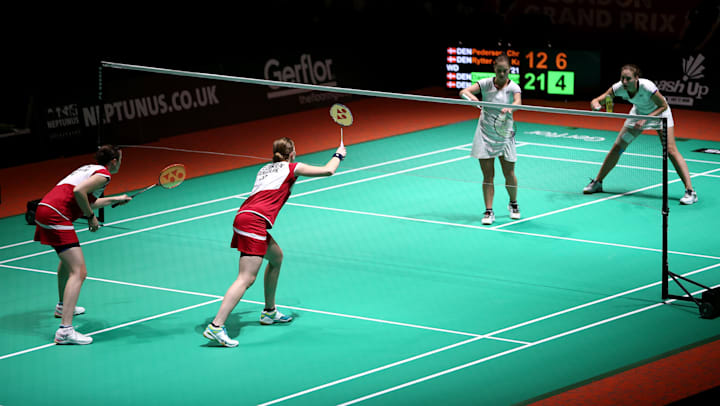
If you prefer doubles over singles, I will inform you about some basic points you can apply to your game, which can help you play good doubles.
Master how to perform a service, return a serve, and third shot- The service box is short in doubles, and due to this, doubles players focus on low serve because high serve can give your opponent a chance to perform a smash.
So you need to master these three shots in service sequence, which are:
- The serve.
- The return of the serve.
- The very first shot after the return of the shot.
Hold your defensive position right- You can’t always attack your opponent, whether singles or doubles.
With offensive skills, you also need to master some defensive skills, for which you need to set up an area and enable yourself and your partner to cover a wide area.
It will help you reach the shuttle easily, even if your opponent plays a powerful smash or any other shot.
Place Your smashes with purpose- Don’t think that attacking in doubles is an easy task because if you perform some continuous smashes without any strategy or planning.
Then it’s all waste of energy.
It would help if you placed your smashes with purposes like:
- Perform a smash straight to the opponent’s body.
- Smash down the tramlines.
- Smash in the gap between the two players.
- Smash all the way cross-court.
Trust your partner, and play as a team- Doubles are a team game, and if you want to score more or win a rally, you need to trust your partner and play as a team, for which you must require coordination, communication, and mutual understanding.
And for this, you need to practice with your partner and improve your skills in doubles.
Work on your footwork- Footwork is the basic thing that matters in both singles and doubles.
A positive point to having a partner is that you don’t have to cover the full court but still have the half-court.
Doubles are about performing explosive, fast, and frequent moves on your toes.
So it would be best if you worked on your footwork for better coordination and mutual understanding.
Badminton Doubles Court

BWF doubles court measures about 44 feet long and 20 feet wide.
And as you know, in doubles, two players are on each side of the court and use the entire standard court.
Click here to know more about its court shape and size in meters.
Final Words
If you are a beginner or new to this sport, I hope this article helps you become a good player.
In this article, I have mentioned all the basic things and explained some of its rules and different types of shots.
I have also indulged some videos in this article so you can easily clear your doubts.
At last, I suggest you go through the post thoroughly to know the basic things about badminton.
In case you have any queries or questions going on in your mind regarding this post, then feel free to ask us or pin up your questions in the comment section below.
